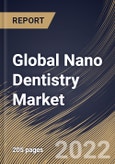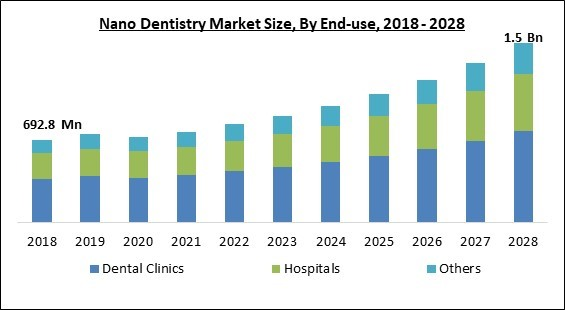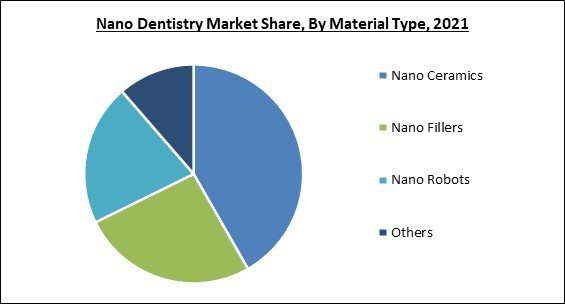The Global Nano Dentistry Market size is expected to reach $1.5 billion by 2028, rising at a market growth of 10.6% CAGR during the forecast period.
Nano dentistry is a technique used to treat, diagnose, and avoid oral and dental diseases. In addition, this technique is utilized for pain relief and maintenance or enhancement of dental health. For instance, with the help of cutting-edge advancement in the industry of saliva exosome diagnostics, doctors can develop antimicrobial, biocompatible dental embeds.
Nano dentistry is utilized to develop digitally any product using atomic building blocks. Nano-impressions, nanoceramics, and nanocomposites are a few of the numerous options. For more accurate dental and gum impressions, nanofillers are already being utilized. Nanofillers provide better flow, hydrophilic properties, and less spacing at dental margins than conventional fillers.
In prosthodontics, nano-zirconia ceramic can be used instead of traditional ceramics to create dentures and crowns that are more robust, endure longer, and resist corrosion. Moreover, with technological advancement, nano dentistry has developed as an advanced science of nanotechnology utilized in enhancing healthcare in the dental by using nanomaterials.
Nanomaterials consist of grains, fibers, crystals, nanoholes, films, and atoms. These nanomaterials can be directed into dimensions such as foils and nanofilms, for instance, two sizes, like carbon nanotubes; three dimensions, such as quantum dots; nanoshells; and dendrimers, among others.
The market research report covers the analysis of key stake holders of the market. Key companies profiled in the report include Dentsply Sirona, Inc., Institut Straumann AG, 3M Company, Zimmer Biomet Holdings, Inc., BioHorizons, Inc. (Henry Schein, Inc.), Danaher Corporation, Mitsui Chemicals, Inc. (Kulzer GmbH), Ivoclar Vivadent AG, aap Implantate AG, and Biotronik SE & Co. KG.
Nano dentistry is a technique used to treat, diagnose, and avoid oral and dental diseases. In addition, this technique is utilized for pain relief and maintenance or enhancement of dental health. For instance, with the help of cutting-edge advancement in the industry of saliva exosome diagnostics, doctors can develop antimicrobial, biocompatible dental embeds.
Nano dentistry is utilized to develop digitally any product using atomic building blocks. Nano-impressions, nanoceramics, and nanocomposites are a few of the numerous options. For more accurate dental and gum impressions, nanofillers are already being utilized. Nanofillers provide better flow, hydrophilic properties, and less spacing at dental margins than conventional fillers.
In prosthodontics, nano-zirconia ceramic can be used instead of traditional ceramics to create dentures and crowns that are more robust, endure longer, and resist corrosion. Moreover, with technological advancement, nano dentistry has developed as an advanced science of nanotechnology utilized in enhancing healthcare in the dental by using nanomaterials.
Nanomaterials consist of grains, fibers, crystals, nanoholes, films, and atoms. These nanomaterials can be directed into dimensions such as foils and nanofilms, for instance, two sizes, like carbon nanotubes; three dimensions, such as quantum dots; nanoshells; and dendrimers, among others.
COVID-19 Impact Analysis
The COVID-19 pandemic has significantly affected the growth of the nano dentistry market. The manufacturing of dental implants has suffered due to the closure of manufacturing facilities and the establishment of quarantine zones in response to the exponentially rising number of COVID-19 cases globally. The nano dentistry market was hampered because elective dental procedures are a high-contact service. Various dental offices were converted into COVID-care centers, affecting multiple dental treatments. As a result, different healthcare methods were postponed, including oral exams, radiography, regular cleanings, cosmetic dental procedures, and other orthodontic treatments.Market Growth Factors
Enhance Chewing Abilities
The food must be flawlessly foundation and ground before being digested; chewing is a fragile balancing act that needs precise synchronization between the jaw, teeth, and tongue. Inadequate chewing of food can lead to choking and digestive issues. One common reason for poor chewing performance is an over-dependence on one side of the mouth owing to dental pain. One method to aid with chewing ability restoration is restorative dentistry.Increasing Dental Problems Among People
One of the major factors driving the growth of the nano dentistry market is the prompt increasing cases of dental cavities, such as tooth loss and caries, among people because of unhealthy food consumption patterns. Moreover, every nation is witnessing a rapid increase in the number and percentage of their geriatric population. According to the World Health Organization’s Global Oral Health Status Report of 2022, approximately 3.5 billion people are affected by oral diseases. More than 2 billion people worldwide are suffering from caries of permanent teeth, and about 514 million children suffer from primary teeth caries. Therefore, these factors will propel the growth of the nano dentistry market during the projection period.Market Restraining Factor
The Risk Of Nanotoxicology And Related Ethical Issues
Genotoxicity is the crucial reason why the implementation of nanotechnology is limited. Alterations in the gene expression profiles, chromosomal mutations, and DNA fragmentation are the genetic alteration that may occur with exposure to the nanomaterials. DNA damage generally occurs due to direct and indirect mechanisms when the nanomaterials enter the human body through oral routes, lungs, or skin. Therefore, the nanotoxicity and the moral and issues related to its use might hamper the growth of the nano dentistry market.Material Type Outlook
Based on the material type, the nano dentistry market is segmented into nano ceramics, nano fillers, nano robots, and others. The nano ceramics segment acquired the highest revenue share in the nano dentistry market in 2021. It is because nano ceramic acquires physical, chemical, and mechanical properties that set them apart from other materials, such as conventional metals, ceramics, and polymers. Nanoceramics are incredibly robust and exhibit excellent resistance to compression and bending.Application Outlook
On the basis of application, the nano dentistry market is divided into preventive dentistry, tooth restoration, dental implants, and others. The tooth restoration segment procured the largest revenue share in the nano dentistry market in 2021. It is because it restores the natural element of the teeth and avoids extra damage from the decomposition. Tooth restoration includes restorative materials mainly utilized to substitute tooth shape damage that happens due to dental caries or tooth wear that can cause dental trauma.End-Use Outlook
By end-use, the nano dentistry market is classified into hospitals, dental clinics, and others. The hospital segment registered a substantial revenue share in the nano dentistry market in 2021. This is due to the increasing number of technological advancements in hospital equipment and medical devices that contribute to the segment"s growth. In addition, clinics and hospitals are incorporating more dental care equipment as people become more conscious of their dental health.Regional Outlook
Region-wise, the nano dentistry market is analyzed across North America, Europe, Asia Pacific, and Lamea. The North America segment acquired the largest revenue share in the nano dentistry market in 2021. This is due to the high investment in R&D, more excellent disposable money, and independent clinics. Additionally, the growth of government funding for dentistry programs is likely to support market expansion.The market research report covers the analysis of key stake holders of the market. Key companies profiled in the report include Dentsply Sirona, Inc., Institut Straumann AG, 3M Company, Zimmer Biomet Holdings, Inc., BioHorizons, Inc. (Henry Schein, Inc.), Danaher Corporation, Mitsui Chemicals, Inc. (Kulzer GmbH), Ivoclar Vivadent AG, aap Implantate AG, and Biotronik SE & Co. KG.
Scope of the Study
By Material Type
- Nano Ceramics
- Nano Fillers
- Nano Robots
- Others
By End-user
- Dental Clinics
- Hospitals
- Others
By Application
- Tooth Restoration
- Dental Implants
- Preventive Dentistry
- Others
By Geography
- North America
- US
- Canada
- Mexico
- Rest of North America
- Europe
- Germany
- UK
- France
- Russia
- Spain
- Italy
- Rest of Europe
- Asia Pacific
- China
- Japan
- India
- South Korea
- Singapore
- Malaysia
- Rest of Asia Pacific
- LAMEA
- Brazil
- Argentina
- UAE
- Saudi Arabia
- South Africa
- Nigeria
- Rest of LAMEA
Key Market Players
List of Companies Profiled in the Report:
- Dentsply Sirona, Inc.
- Institut Straumann AG
- 3M Company
- Zimmer Biomet Holdings, Inc.
- BioHorizons, Inc. (Henry Schein, Inc.)
- Danaher Corporation
- Mitsui Chemicals, Inc. (Kulzer GmbH)
- Ivoclar Vivadent AG
- aap Implantate AG
- Biotronik SE & Co. KG
Unique Offerings
- Exhaustive coverage
- The highest number of market tables and figures
- Subscription-based model available
- Guaranteed best price
- Assured post sales research support with 10% customization free
Table of Contents
Chapter 1. Market Scope & Methodology1.1 Market Definition
1.2 Objectives
1.3 Market Scope
1.4 Segmentation
1.4.1 Global Nano Dentistry Market, by Material Type
1.4.2 Global Nano Dentistry Market, by End User
1.4.3 Global Nano Dentistry Market, by Application
1.4.4 Global Nano Dentistry Market, by Geography
1.5 Methodology for the research
Chapter 2. Market Overview
2.1 Introduction
2.1.1 Overview
2.1.1.1 Market Composition & Scenarios
2.2 Key Factors Impacting the Market
2.2.1 Market Drivers
2.2.2 Market Restraints
Chapter 3. Global Nano Dentistry Market by Material Type
3.1 Global Nano Ceramics Market by Region
3.2 Global Nano Fillers Market by Region
3.3 Global Nano Robots Market by Region
3.4 Global Others Market by Region
Chapter 4. Global Nano Dentistry Market by End-use
4.1 Global Dental Clinics Market by Region
4.2 Global Hospitals Market by Region
4.3 Global Others Market by Region
Chapter 5. Global Nano Dentistry Market by Application
5.1 Global Tooth Restoration Market by Region
5.2 Global Dental Implants Market by Region
5.3 Global Preventive Dentistry Market by Region
5.4 Global Others Market by Region
Chapter 6. Global Nano Dentistry Market by Region
6.1 North America Nano Dentistry Market
6.1.1 North America Nano Dentistry Market by Material Type
6.1.1.1 North America Nano Ceramics Market by Country
6.1.1.2 North America Nano Fillers Market by Country
6.1.1.3 North America Nano Robots Market by Country
6.1.1.4 North America Others Market by Country
6.1.2 North America Nano Dentistry Market by End-use
6.1.2.1 North America Dental Clinics Market by Country
6.1.2.2 North America Hospitals Market by Country
6.1.2.3 North America Others Market by Country
6.1.3 North America Nano Dentistry Market by Application
6.1.3.1 North America Tooth Restoration Market by Country
6.1.3.2 North America Dental Implants Market by Country
6.1.3.3 North America Preventive Dentistry Market by Country
6.1.3.4 North America Others Market by Country
6.1.4 North America Nano Dentistry Market by Country
6.1.4.1 US Nano Dentistry Market
6.1.4.1.1 US Nano Dentistry Market by Material Type
6.1.4.1.2 US Nano Dentistry Market by End-use
6.1.4.1.3 US Nano Dentistry Market by Application
6.1.4.2 Canada Nano Dentistry Market
6.1.4.2.1 Canada Nano Dentistry Market by Material Type
6.1.4.2.2 Canada Nano Dentistry Market by End-use
6.1.4.2.3 Canada Nano Dentistry Market by Application
6.1.4.3 Mexico Nano Dentistry Market
6.1.4.3.1 Mexico Nano Dentistry Market by Material Type
6.1.4.3.2 Mexico Nano Dentistry Market by End-use
6.1.4.3.3 Mexico Nano Dentistry Market by Application
6.1.4.4 Rest of North America Nano Dentistry Market
6.1.4.4.1 Rest of North America Nano Dentistry Market by Material Type
6.1.4.4.2 Rest of North America Nano Dentistry Market by End-use
6.1.4.4.3 Rest of North America Nano Dentistry Market by Application
6.2 Europe Nano Dentistry Market
6.2.1 Europe Nano Dentistry Market by Material Type
6.2.1.1 Europe Nano Ceramics Market by Country
6.2.1.2 Europe Nano Fillers Market by Country
6.2.1.3 Europe Nano Robots Market by Country
6.2.1.4 Europe Others Market by Country
6.2.2 Europe Nano Dentistry Market by End-use
6.2.2.1 Europe Dental Clinics Market by Country
6.2.2.2 Europe Hospitals Market by Country
6.2.2.3 Europe Others Market by Country
6.2.3 Europe Nano Dentistry Market by Application
6.2.3.1 Europe Tooth Restoration Market by Country
6.2.3.2 Europe Dental Implants Market by Country
6.2.3.3 Europe Preventive Dentistry Market by Country
6.2.3.4 Europe Others Market by Country
6.2.4 Europe Nano Dentistry Market by Country
6.2.4.1 Germany Nano Dentistry Market
6.2.4.1.1 Germany Nano Dentistry Market by Material Type
6.2.4.1.2 Germany Nano Dentistry Market by End-use
6.2.4.1.3 Germany Nano Dentistry Market by Application
6.2.4.2 UK Nano Dentistry Market
6.2.4.2.1 UK Nano Dentistry Market by Material Type
6.2.4.2.2 UK Nano Dentistry Market by End-use
6.2.4.2.3 UK Nano Dentistry Market by Application
6.2.4.3 France Nano Dentistry Market
6.2.4.3.1 France Nano Dentistry Market by Material Type
6.2.4.3.2 France Nano Dentistry Market by End-use
6.2.4.3.3 France Nano Dentistry Market by Application
6.2.4.4 Russia Nano Dentistry Market
6.2.4.4.1 Russia Nano Dentistry Market by Material Type
6.2.4.4.2 Russia Nano Dentistry Market by End-use
6.2.4.4.3 Russia Nano Dentistry Market by Application
6.2.4.5 Spain Nano Dentistry Market
6.2.4.5.1 Spain Nano Dentistry Market by Material Type
6.2.4.5.2 Spain Nano Dentistry Market by End-use
6.2.4.5.3 Spain Nano Dentistry Market by Application
6.2.4.6 Italy Nano Dentistry Market
6.2.4.6.1 Italy Nano Dentistry Market by Material Type
6.2.4.6.2 Italy Nano Dentistry Market by End-use
6.2.4.6.3 Italy Nano Dentistry Market by Application
6.2.4.7 Rest of Europe Nano Dentistry Market
6.2.4.7.1 Rest of Europe Nano Dentistry Market by Material Type
6.2.4.7.2 Rest of Europe Nano Dentistry Market by End-use
6.2.4.7.3 Rest of Europe Nano Dentistry Market by Application
6.3 Asia Pacific Nano Dentistry Market
6.3.1 Asia Pacific Nano Dentistry Market by Material Type
6.3.1.1 Asia Pacific Nano Ceramics Market by Country
6.3.1.2 Asia Pacific Nano Fillers Market by Country
6.3.1.3 Asia Pacific Nano Robots Market by Country
6.3.1.4 Asia Pacific Others Market by Country
6.3.2 Asia Pacific Nano Dentistry Market by End-use
6.3.2.1 Asia Pacific Dental Clinics Market by Country
6.3.2.2 Asia Pacific Hospitals Market by Country
6.3.2.3 Asia Pacific Others Market by Country
6.3.3 Asia Pacific Nano Dentistry Market by Application
6.3.3.1 Asia Pacific Tooth Restoration Market by Country
6.3.3.2 Asia Pacific Dental Implants Market by Country
6.3.3.3 Asia Pacific Preventive Dentistry Market by Country
6.3.3.4 Asia Pacific Others Market by Country
6.3.4 Asia Pacific Nano Dentistry Market by Country
6.3.4.1 China Nano Dentistry Market
6.3.4.1.1 China Nano Dentistry Market by Material Type
6.3.4.1.2 China Nano Dentistry Market by End-use
6.3.4.1.3 China Nano Dentistry Market by Application
6.3.4.2 Japan Nano Dentistry Market
6.3.4.2.1 Japan Nano Dentistry Market by Material Type
6.3.4.2.2 Japan Nano Dentistry Market by End-use
6.3.4.2.3 Japan Nano Dentistry Market by Application
6.3.4.3 India Nano Dentistry Market
6.3.4.3.1 India Nano Dentistry Market by Material Type
6.3.4.3.2 India Nano Dentistry Market by End-use
6.3.4.3.3 India Nano Dentistry Market by Application
6.3.4.4 South Korea Nano Dentistry Market
6.3.4.4.1 South Korea Nano Dentistry Market by Material Type
6.3.4.4.2 South Korea Nano Dentistry Market by End-use
6.3.4.4.3 South Korea Nano Dentistry Market by Application
6.3.4.5 Singapore Nano Dentistry Market
6.3.4.5.1 Singapore Nano Dentistry Market by Material Type
6.3.4.5.2 Singapore Nano Dentistry Market by End-use
6.3.4.5.3 Singapore Nano Dentistry Market by Application
6.3.4.6 Malaysia Nano Dentistry Market
6.3.4.6.1 Malaysia Nano Dentistry Market by Material Type
6.3.4.6.2 Malaysia Nano Dentistry Market by End-use
6.3.4.6.3 Malaysia Nano Dentistry Market by Application
6.3.4.7 Rest of Asia Pacific Nano Dentistry Market
6.3.4.7.1 Rest of Asia Pacific Nano Dentistry Market by Material Type
6.3.4.7.2 Rest of Asia Pacific Nano Dentistry Market by End-use
6.3.4.7.3 Rest of Asia Pacific Nano Dentistry Market by Application
6.4 LAMEA Nano Dentistry Market
6.4.1 LAMEA Nano Dentistry Market by Material Type
6.4.1.1 LAMEA Nano Ceramics Market by Country
6.4.1.2 LAMEA Nano Fillers Market by Country
6.4.1.3 LAMEA Nano Robots Market by Country
6.4.1.4 LAMEA Others Market by Country
6.4.2 LAMEA Nano Dentistry Market by End-use
6.4.2.1 LAMEA Dental Clinics Market by Country
6.4.2.2 LAMEA Hospitals Market by Country
6.4.2.3 LAMEA Others Market by Country
6.4.3 LAMEA Nano Dentistry Market by Application
6.4.3.1 LAMEA Tooth Restoration Market by Country
6.4.3.2 LAMEA Dental Implants Market by Country
6.4.3.3 LAMEA Preventive Dentistry Market by Country
6.4.3.4 LAMEA Others Market by Country
6.4.4 LAMEA Nano Dentistry Market by Country
6.4.4.1 Brazil Nano Dentistry Market
6.4.4.1.1 Brazil Nano Dentistry Market by Material Type
6.4.4.1.2 Brazil Nano Dentistry Market by End-use
6.4.4.1.3 Brazil Nano Dentistry Market by Application
6.4.4.2 Argentina Nano Dentistry Market
6.4.4.2.1 Argentina Nano Dentistry Market by Material Type
6.4.4.2.2 Argentina Nano Dentistry Market by End-use
6.4.4.2.3 Argentina Nano Dentistry Market by Application
6.4.4.3 UAE Nano Dentistry Market
6.4.4.3.1 UAE Nano Dentistry Market by Material Type
6.4.4.3.2 UAE Nano Dentistry Market by End-use
6.4.4.3.3 UAE Nano Dentistry Market by Application
6.4.4.4 Saudi Arabia Nano Dentistry Market
6.4.4.4.1 Saudi Arabia Nano Dentistry Market by Material Type
6.4.4.4.2 Saudi Arabia Nano Dentistry Market by End-use
6.4.4.4.3 Saudi Arabia Nano Dentistry Market by Application
6.4.4.5 South Africa Nano Dentistry Market
6.4.4.5.1 South Africa Nano Dentistry Market by Material Type
6.4.4.5.2 South Africa Nano Dentistry Market by End-use
6.4.4.5.3 South Africa Nano Dentistry Market by Application
6.4.4.6 Nigeria Nano Dentistry Market
6.4.4.6.1 Nigeria Nano Dentistry Market by Material Type
6.4.4.6.2 Nigeria Nano Dentistry Market by End-use
6.4.4.6.3 Nigeria Nano Dentistry Market by Application
6.4.4.7 Rest of LAMEA Nano Dentistry Market
6.4.4.7.1 Rest of LAMEA Nano Dentistry Market by Material Type
6.4.4.7.2 Rest of LAMEA Nano Dentistry Market by End-use
6.4.4.7.3 Rest of LAMEA Nano Dentistry Market by Application
Chapter 7. Company Profiles
7.1 Dentsply Sirona, Inc.
7.1.1 Company Overview
7.1.2 Financial Analysis
7.1.3 Regional & Segmental Analysis
7.1.4 Research & Development Expenses
7.1.5 Recent strategies and developments:
7.1.5.1 Product Launches and Product Expansions:
7.2 Institut Straumann AG
7.2.1 Company Overview
7.2.2 Financial Analysis
7.2.3 Regional Analysis
7.3 3M Company
7.3.1 Company Overview
7.3.2 Financial Analysis
7.3.3 Segmental and Regional Analysis
7.3.4 Research & Development Expense
7.3.5 Recent strategies and developments:
7.3.5.1 Product Launches and Product Expansions:
7.4 Zimmer Biomet Holdings, Inc.
7.4.1 Company Overview
7.4.2 Financial Analysis
7.4.3 Segmental and Regional Analysis
7.4.4 Research & Development Expense
7.5 BioHorizons, Inc. (Henry Schein, Inc.)
7.5.1 Company Overview
7.5.2 Financial Analysis
7.5.3 Segmental and Regional Analysis
7.6 Danaher Corporation
7.6.1 Company Overview
7.6.2 Financial Analysis
7.6.3 Segmental and Regional Analysis
7.6.4 Research & Development Expense
7.7 Mitsui Chemicals, Inc. (Kulzer GmbH)
7.7.1 Company Overview
7.7.2 Financial Analysis
7.7.3 Segmental and Regional Analysis
7.7.4 Research & Development Expense
7.8 Ivoclar Vivadent AG
7.8.1 Company Overview
7.9 aap Implantate AG
7.9.1 Company Overview
7.10. Biotronik SE & Co. KG
7.10.1 Company Overview
Companies Mentioned
- Dentsply Sirona, Inc.
- Institut Straumann AG
- 3M Company
- Zimmer Biomet Holdings, Inc.
- BioHorizons, Inc. (Henry Schein, Inc.)
- Danaher Corporation
- Mitsui Chemicals, Inc. (Kulzer GmbH)
- Ivoclar Vivadent AG
- aap Implantate AG
- Biotronik SE & Co. KG
Methodology

LOADING...










